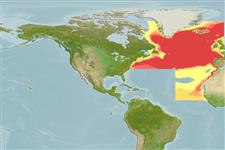Environment: milieu / climate zone / intervalo de profundidade / distribution range
Ecologia
marinhas batipelágico; intervalo de profundidade 0 - 3000 m (Ref. 27000). Deep-water; 73°N - 10°N, 77°W - 1°W
Eastern Atlantic: scattered records from Greenland to Cape Verde. Also known from Western Atlantic.
Tamanho / Peso / Idade
Maturidade: Lm ? range ? - ? cm
Max length : 161 cm TL macho/indeterminado; (Ref. 27000)
Bathypelagic (Ref. 58426). Feeds on fishes. Oviparous, reduction of jaws and complete loss of teeth in sexually mature specimens of both sexes. Mature males with greatly enlarged olfactory organs (Ref. 6718). Minimum depth from Ref. 58018.
Life cycle and mating behavior
Maturidade | Reprodução | Desova | Ovos | Fecundidade | Larvas
Nielsen, J.G. and E. Bertelsen, 1990. Saccopharyngidae. p. 204-205. In J.C. Quero, J.C. Hureau, C. Karrer, A. Post and L. Saldanha (eds.) Check-list of the fishes of the eastern tropical Atlantic (CLOFETA). JNICT, Lisbon; SEI, Paris; and UNESCO, Paris. Vol. 1. (Ref. 6539)
Categoria na Lista Vermelha da IUCN (Ref. 130435: Version 2025-1)
Ameaça para o homem
Harmless
Utilização humana
Ferramentas
Relatórios especiais
Descarregue XML
Fontes da internet
Estimates based on models
Preferred temperature (Ref.
123201): 2.1 - 11.1, mean 6.1 °C (based on 371 cells).
Phylogenetic diversity index (Ref.
82804): PD
50 = 0.5020 [Uniqueness, from 0.5 = low to 2.0 = high].
Bayesian length-weight: a=0.00102 (0.00046 - 0.00225), b=3.06 (2.88 - 3.24), in cm total length, based on all LWR estimates for this body shape (Ref.
93245).
Nível Trófico (Ref.
69278): 4.5 ±0.80 se; based on food items.
Resiliência (Ref.
120179): Muito baixo, tempo mínimo de duplicação da população maior que 14 anos (Assuming semelparity and tm>10).
Fishing Vulnerability (Ref.
59153): Very high vulnerability (90 of 100).
🛈
